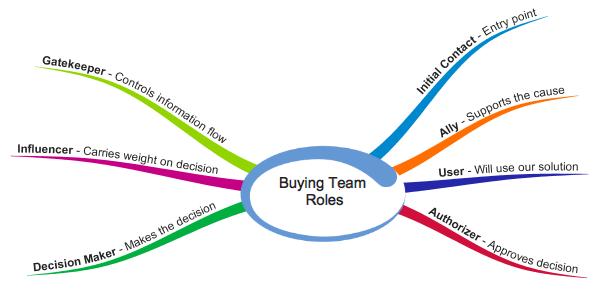Our firm began practicing fractional sales management in early 2006, and nearly 20 years later,…

Who’s A Better Salesperson, You or Your Prospect?
Just for fun, imagine one of your prospects from a recent selling opportunity who has no sales experience is asked to join your sales team and sell in your place. They are now the salesperson and you are their coach. You can coach them from the office, but you can’t meet with prospects and customers any longer because that is their job. Would you be willing to put your income and job security in their hands? Here’s the scary part of this story. It’s already happening to most of you during your current selling situations. When you’re not allowed to meet with all the parties involved in the buying decision (the buying team) you’re left with little choice other than hoping your prospects can do your selling for you.
It’s not always easy to be granted access to the buying team, but it should be your goal to do so. Improving your ability to convince your initial contact of the value of having you meet with their buying team will be very profitable. Here are nine steps to help you be more successful at doing your own selling while better serving your customers.
Make a decision that meeting all buying team members is simply how you work. Decide that you must meet with the buying team members during your discovery time in order for you to present a proposal. You’ll have to believe that meeting with everyone is helpful to you and your potential customer to gain their trust.
Clarify your intention. Your intention must be to serve the customer and help them get what they want more than you getting what you want. Buyers expect sellers to have a biased intention of selling their product more than helping them make a good decision. You’ll need to overcome this. First, clarify your intention in your mind and then convey it through your actions to your prospect. You might need to check your ego in at the door and put your customers needs ahead of yours. Remember, if you help enough people get what they want, you’ll get what you need.
Position your intentions of meeting with the buying team early. After rapport is developed with a new prospect, explain how your process normally works. Let them know you always spend a little time with each member of the buying team in order to better prepare a solution that meets the collective goals of the group. Then ask if they are accustomed to this interview type process. You want to gain understanding to their acceptance of this idea. Most will be guarded but it will help you know where you need to build trust to gain access.
Earn the trust of your initial contact. Trust will start when they believe your intention is to help them. Then it’s important to demonstrate respect for their preferred buying process. Be careful not to challenge their process too early if it seems it might not serve them. Always seek to understand before being understood. Once you have understood their process and gained trust, you can then make alternative suggestions. Being introduced to the buying team is like being referred. A referral is given when someone trusts you, understands your value, and believes it would be worth the referred persons’ time to meet with you. They also must believe it’s in their best interest to refer you.
Your meetings cannot be about promoting your product. Your interview should help you design a solution that best fits the buying teams’ collective wants and motives. The meetings must be about them. At a minimum, you want to come away from each individual meeting with the two objectives listed below.
A. Their personal motive or objective they see in making this purchase. Understand how their world will change if their problems were fixed.
B. Their personal criteria in selecting a vendor. They might share the company criteria but help them articulate what is important to them.
Get to know the buying team through your initial contact. People usually like to share about others, so let your contact educate you. Ask questions about the buying team and their influence or involvement. When listening and learning about the buying team members take good notes. You’ll find something that will help you with your compelling reason to request a meeting with each.
Provide a compelling reason to be invited to meet with everyone on the buying team. You’ll need to be creative with your reasoning and this reasoning will only come across if you are working from an intention of service. You might find ideas from the notes you took while learning about the team members. Explain how understanding from each persons’ perspective on how the solution will help their individual focus of the business can help your design and presentation be best understood. Also, since there are always louder voices than others on a buying team, your interview process can help everyone’s voice be heard to help all buying team members make a decision with the collective objectives.
If there is resistance, start with one team member at the highest possible level to prove yourself. Ask if you could demonstrate your value by meeting with one person before they decide to allow you to meet the whole team. Try and meet with the highest level person they will allow. Keep the meeting to a short commitment, no more than 30 minutes and even as little as 15 minuts if that’s all you can get. If all you do is come away with the two objectives listed above, you’ll be able to prepare a solution that is focused on everyone’s needs and criteria for a decision.
If you cannot meet with the buying team you must make a decision to proceed or decline the opportunity. When you truly make a decision to make meeting with the buying team a requirement for you rather than a hope, you’ll see this happen more often. When you understand the true value of these meetings and how they help buyers make decisions, you’ll be less inclined to work with opportunities that are closed to this approach. It’s always your call, but if you do back out, present a reason that is more about you than them.
Example: Mr. Contact, unfortunately I’ll need to decline proposing a solution with you. It’s not my intention to change your preferred buying approach, but it makes it difficult for me to do the job I am proud of. I create solutions for my customers geared toward all buying team members objectives and criteria as they contribute to the whole. It’s just too hard for me to do this without meeting with everyone, I hope you can respect this decision.
There is a back door. If you decide to move forward without the interviews you can request additional time during your presentation to dialogue through the interview before presenting your solution. This will allow you to tailor your final presentation toward each members key objectives and criteria. It’s not ideal, but it’s better than presenting without the interview time.
Selling seems to always be evolving in small ways, but doing your own selling by meeting with all buyers is not a new concept. Information on your website, leave behinds, proposals and webinars will educate your buyers on your products and general solution. These things will never answer the question about what a buying team members’ objectives are, and what criteria they are looking for in a supplier. It’s your job to get the answers to these questions and make sure they fit with your solution. You are the salesperson and you should always do your own selling. After all, you are a much better salesperson than your prospects.




[…] main contact will convince everyone on his decision-making team to buy instead of doing our job by meeting everyone and doing our own selling. Another scenario is when deals start pouring in and we stop doing the hard work that led to the […]
[…] Your sales team controls their activity. They control the type and volume of high-payoff activity they’re doing. This would include prospecting and referral generating. Their activity should include trust-building and proposals. Sales activity should also include meetings with all decision-makers and influencers. […]